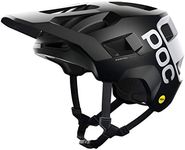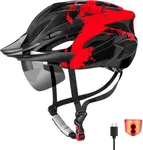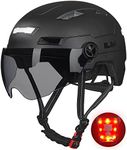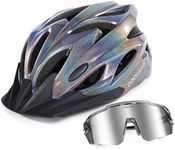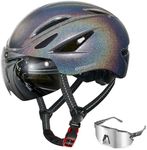Buying Guide for the Best Women Bike Helmets
Choosing the right bike helmet is crucial for ensuring safety and comfort while cycling. A well-fitted helmet can protect you from head injuries in case of an accident, and it should also be comfortable enough to wear for extended periods. When selecting a helmet, consider factors such as fit, ventilation, weight, and style. It's important to try on different helmets to find one that fits snugly without being too tight, and to ensure it meets safety standards. Here are some key specifications to consider when choosing a women's bike helmet.FitThe fit of a bike helmet is perhaps the most important factor to consider. A helmet that fits well will stay securely in place and provide the best protection. Helmets come in different sizes, usually measured in centimeters, corresponding to the circumference of your head. To find the right size, measure your head just above your eyebrows and choose a helmet that matches this measurement. Some helmets also have adjustable fit systems, such as dial adjusters or adjustable straps, which can help you achieve a more customized fit. It's important to try on the helmet and ensure it feels snug but not too tight, and that it doesn't move around when you shake your head.
VentilationVentilation refers to the number and size of vents in a helmet, which allow air to flow through and keep your head cool. This is especially important if you plan to ride in warm weather or for long distances. Helmets with more vents generally offer better airflow, but they may also be lighter and less protective. Consider how much ventilation you need based on your typical riding conditions. If you often ride in hot climates, look for a helmet with plenty of large vents. If you ride in cooler weather, you might prioritize other features over ventilation.
WeightThe weight of a helmet can affect your comfort, especially on long rides. Lighter helmets are generally more comfortable to wear for extended periods, as they put less strain on your neck and shoulders. However, lighter helmets may also be more expensive. When considering weight, think about how often and how long you plan to wear the helmet. If you frequently go on long rides, a lighter helmet might be worth the investment. For shorter, casual rides, a slightly heavier helmet may be perfectly adequate.
Safety StandardsSafety standards ensure that a helmet provides a basic level of protection in the event of a crash. In many countries, helmets must meet specific safety standards, such as CPSC in the United States or CE in Europe. These standards test the helmet's ability to absorb impact and protect the head. When choosing a helmet, make sure it meets the safety standards required in your region. This information is usually found on a sticker inside the helmet. Prioritizing safety standards is crucial, as it ensures the helmet will perform effectively when needed.
Style and DesignWhile safety and comfort are the most important factors, the style and design of a helmet can also be important to many riders. Helmets come in a variety of colors, patterns, and shapes, allowing you to choose one that matches your personal style. Some helmets also have additional features like visors, which can provide extra sun protection, or reflective elements for increased visibility. Consider what style elements are important to you and how they might enhance your riding experience. Ultimately, the best helmet is one that you feel confident and comfortable wearing.
